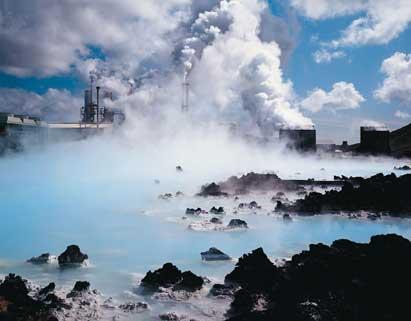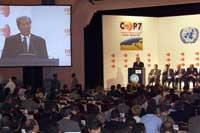Cracks in the Kyoto Protocol
2001/03/30 Carton Virto, Eider - Elhuyar Zientzia
At the beginning of March the countries that make up the G-8 (United States, Russia, Germany, Japan, United Kingdom, Canada, France and Italy) met extraordinarily in Trieste (Italy) and decided to comply with the Kyoto Protocol. It was decided to reduce gas emissions and make the reduction in their own country, without buying the emission quotas to other countries. But now, the George Bush administration has taken the word and has resigned from controlling the CO2 dumping. According to the director of the U.S. Environment Agency, they are not interested in implementing the Protocol and wasting time with an unfunctioning process makes no sense.
Energy problems

Half of the electricity produced in the United States is done in coal-fueled power plants, and President Bush has said that regulating the sector would significantly increase the price of electricity. In addition, the US energy sector has been in crisis since its liberalization plan was launched in 1996. It seems that the plan was excessively complex and with little sense of future and can cause the decline of the energy sector. Despite the economic implications, the energy consequences have been remarkable, especially in California. At present, California's energy supply is not capable of satisfying demand, and residents suffer from electricity cuts.
However, the United States has always shown a cold attitude towards the commitments made in Kyoto. At the last summit held in The Hague in November last year, the debates were also tough and the defeat was total. Then, it was necessary to establish and define mechanisms to fulfill the commitments made in Kyoto.
On the one hand, control mechanisms had to be agreed for countries that did not meet the word and deadlines, such as fines. On the other hand, financing and, finally, flexible mechanisms. The Kyoto Protocol establishes that countries that are not able to reduce their emissions could compensate for the excesses of emissions through other mechanisms such as the implementation of clean development technologies in developing countries or trade in emission rights. In The Hague, it was necessary to determine what clean development technologies were, as well as to limit or not trade in emission rights.

The United States, Canada, Australia, New Zealand, Japan and Russia were supporters of not restricting trade and not imposing fines on those who did not meet their commitment. However, the European Union positioned itself against. On the other hand, they claimed that developing countries are not willing to limit their development within emissions, and oil producing countries also showed their opinion. In The Hague each stayed and the meeting ended without agreement. It is believed that it was the meeting to give the last touches to the Kyoto Protocol and put it into force.
Can Kyoto be frozen?
The United States accounts for 6% of the global population, but accounts for 25% of the total emissions into the atmosphere. If they do not continue with the commitment made in Kyoto, the fight against climate change would be very limited. However, the prosecution of all the demons and evils of the United States is too simple and comfortable. For because of this,
While the European Union insists on good compliance purposes of the Kyoto Protocol, none of its members have ratified the Protocol. It was signed by 84 countries, but only 33 ratified. The Kyoto Protocol will not enter into force until its ratification by 45% of the signatories, although there are no countries emitting more gases among those who ratify it. And among the 33 countries that have ratified there is none industrialized. In addition, the environmental organization WWF has recently denounced that in 2010 the most emitting countries in Europe will issue 220 million tons of gas to the atmosphere more than agreed. These countries are Germany, France, Spain, the United Kingdom, Sweden and the Netherlands, representing 70% of what was issued in the European Union.

Gai honi buruzko eduki gehiago
Elhuyarrek garatutako teknologia






